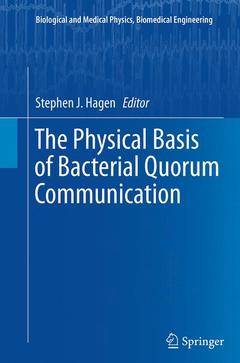The Physical Basis of Bacterial Quorum Communication, Softcover reprint of the original 1st ed. 2015 Biological and Medical Physics, Biomedical Engineering Series
Coordonnateur : Hagen Stephen J.

Chapter 1. Introduction.- Chapter 2. Modeling of Signal Transduction by The Quorum-Sensing Pathway in the Vibrios.- Chapter 3. Stochastic Effects in Quorum Sensing.-Chapter 4. Spatial Structure of Microbes in Nature and the Biophysics of Cell-Cell Communication.- Chapter 5. Functionality of Autoinducer Systems in Complex Environments.- Chapter 6. Localization of Quorum Sensing by Extracellular Polymeric Substances (EPS): Considerations of in Situ Signaling.- Chapter 7. Swimming in Information? Physics Limits to Learning by Quorum Sensing.- Chapter 8. Interplay Between Sibling Bacterial Colonies.- Chapter 9. Mathematical Insights Into the Role of Feedback in Quorum-Sensing Architectures.- Chapter 10. The Role of Biosurfactants in Bacterial Systems.- Chapter 11. Ecology of a Simple Synthetic Biofilm.- Chapter 12. Engineering Cell-to-Cell Communication To Explore Fundamental Questions in Ecology and Evolution.
Date de parution : 08-2016
Ouvrage de 252 p.
15.5x23.5 cm
Date de parution : 09-2014
Ouvrage de 252 p.
15.5x23.5 cm
Thème de The Physical Basis of Bacterial Quorum Communication :
Mots-clés :
Chemical Communication; Diffusion; Information Theory; Microbiology; Noisy Quorum Systems; QS; QS Regulatory Networks; Quorum Sensing; Quorum Sensing Modeling; Quorum Sensing Networks Architecture; Quorum Sensing Physical Aspects; Quorum Sensing Quantitative Methods; Spatiotemporal QS Phenomena; Stochastic Gene Expression; Synthetic QS Systems; systems biology; gene expression



